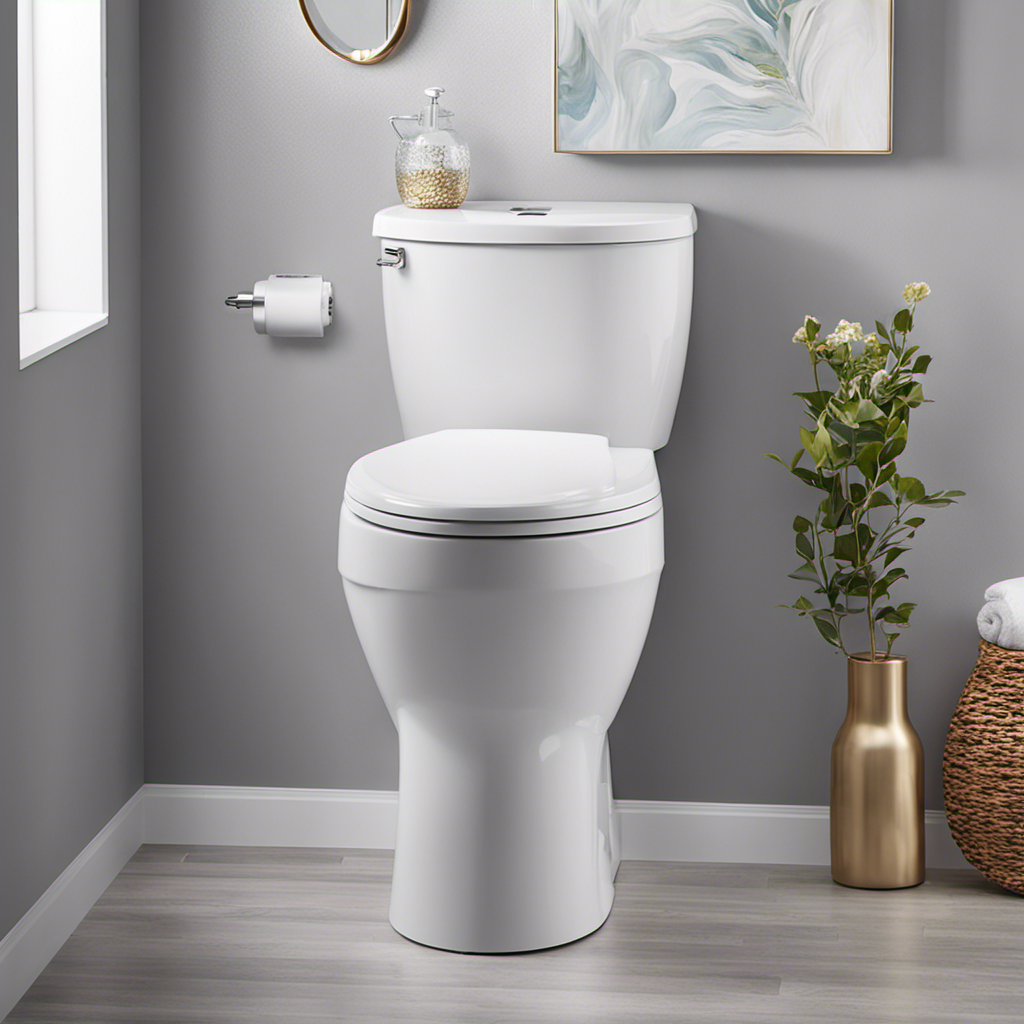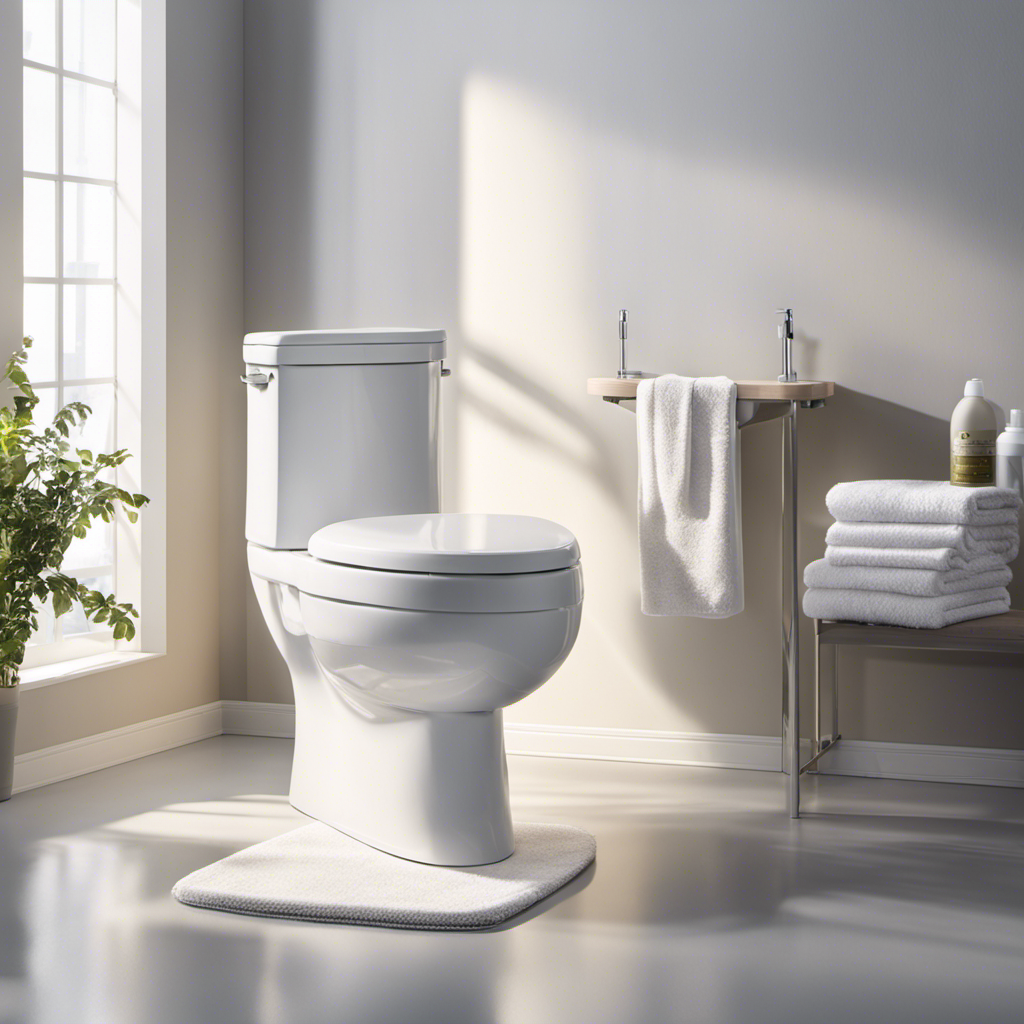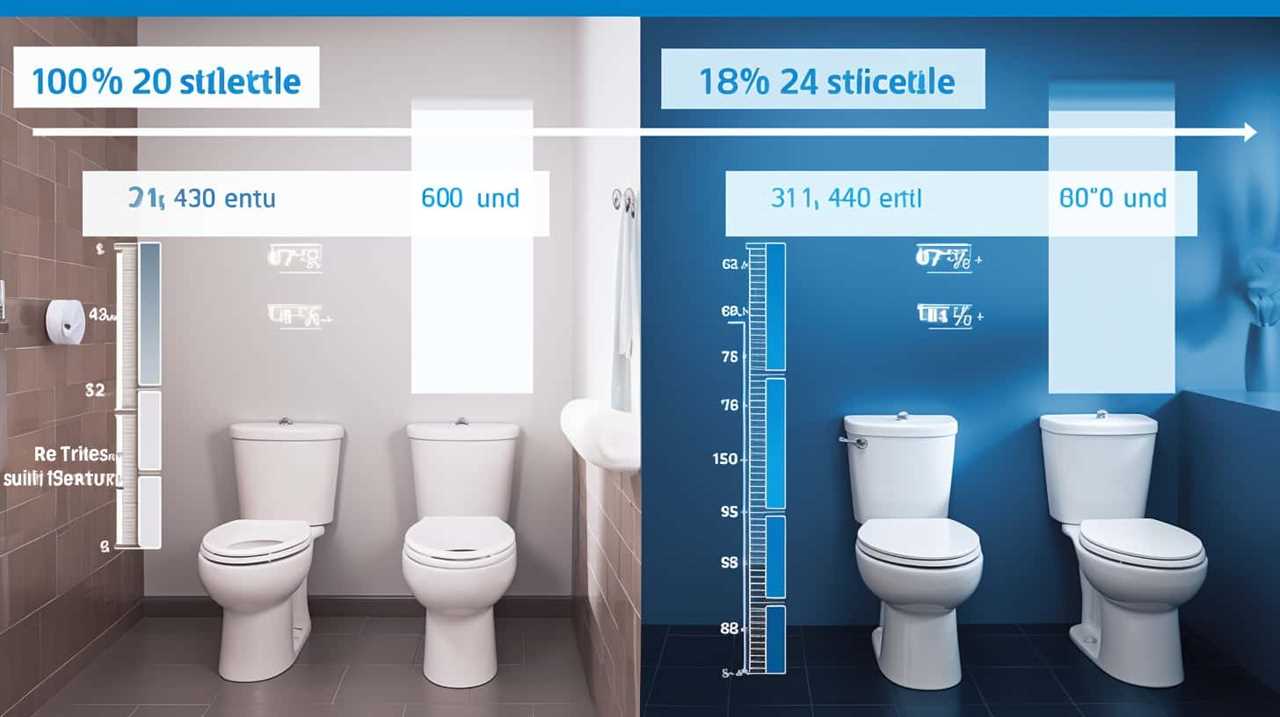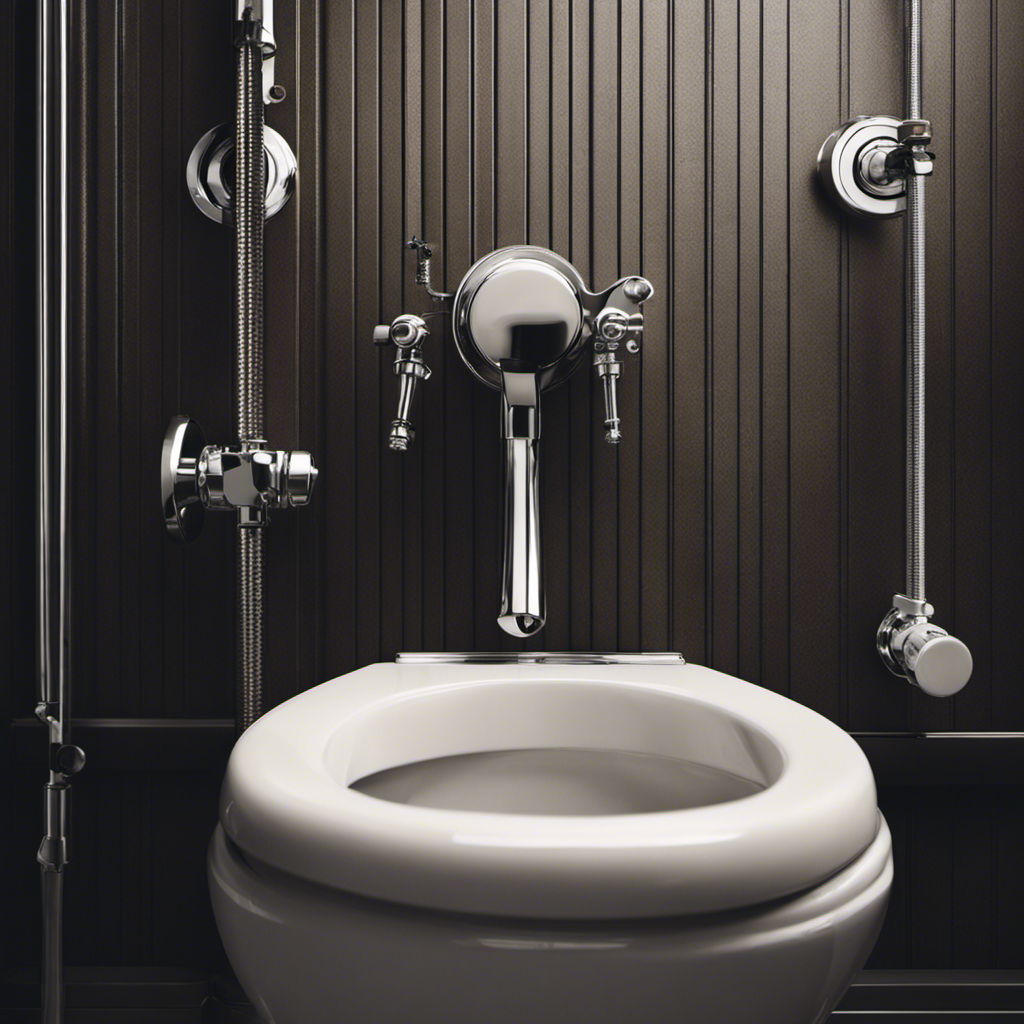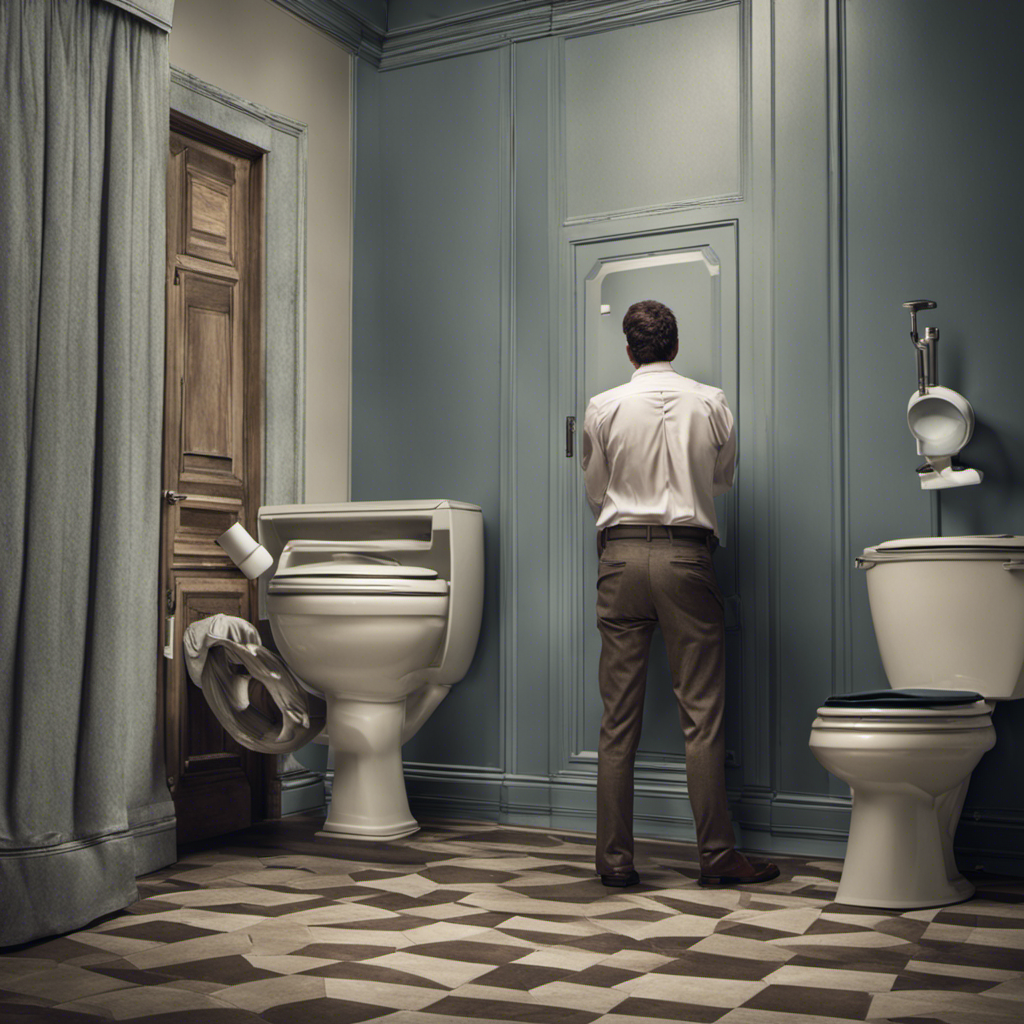Hey there, folks! Got a stinky situation on your hands with a sewer smell wafting from your toilet? Well, fear not, because I’ve got just the solution for you.
In this handy guide, I’ll walk you through the step-by-step process of banishing that offensive odor once and for all. We’ll dive deep into identifying the source, checking and cleaning the trap, inspecting the vent pipe, and even tackling the toilet bowl and surrounding areas.
So, let’s roll up our sleeves and get rid of that pesky sewer smell together!
Key Takeaways
- Check the toilet’s wax ring for cracks or gaps and replace if necessary.
- Use a plumber’s snake to dislodge any blockages in the trap.
- Regularly clean the trap to remove debris and prevent odor-causing bacteria.
- Locate the vent pipe on the roof and inspect for obstructions.
Identifying the Source of the Sewer Smell
To identify the source of the sewer smell, start by checking the toilet’s wax ring and pipe connections. The wax ring is a seal between the toilet and the floor, and if it is worn or damaged, it can allow sewer gases to escape. Inspect the ring for any cracks or gaps, and if necessary, replace it.
Next, examine the pipe connections. These connections can become loose or damaged over time, leading to sewer odor in the bathroom. Tighten any loose connections and replace any damaged pipes if needed.
Additionally, check the vent pipe for any clogs or obstructions, as this can also contribute to the smell.
Checking and Cleaning the Toilet Trap
When it comes to trap cleaning techniques, it’s important to use the right tools and methods to effectively remove any debris or buildup that may be causing the odor.
One effective technique is using a plumber’s snake to dislodge any blockages in the trap.
Additionally, using a baking soda and vinegar solution can help to break down any organic matter and eliminate foul odors.
To prevent future odor, regular maintenance is key. This includes flushing the trap with hot water and using enzyme-based cleaners to keep it clear and odor-free.
Trap Cleaning Techniques
One effective way to address the sewer smell from the toilet is by regularly cleaning the trap. The trap is a curved section of the toilet’s plumbing that prevents sewer gases from entering the bathroom. Over time, debris and waste can accumulate in the trap, leading to unpleasant odors. By cleaning the trap, you can eliminate these odors and improve the overall hygiene of your toilet. Here are some techniques for cleaning the trap:
| Technique | Steps |
|---|---|
| Plunger Method | 1. Fill the toilet bowl with water. |
- Place a plunger over the drain hole.
- Push and pull the plunger vigorously to create suction and dislodge any clogs.
- Repeat as necessary.
- Flush the toilet to check if the odor has been eliminated. |
| Vinegar and Baking Soda Method | 1. Pour one cup of baking soda into the toilet bowl. - Add two cups of vinegar.
- Let the mixture sit for at least 30 minutes.
- Use a toilet brush to scrub the trap and remove any debris.
- Flush the toilet to rinse the trap.
- Repeat if necessary. |
Regular trap cleaning is an essential part of toilet maintenance and odor control. By following these techniques, you can ensure a fresh and odor-free bathroom experience.
Preventing Future Odor
To prevent future odors, you should regularly clean the trap of your toilet. Regular maintenance benefits not only the functionality of your toilet but also eliminates unpleasant smells.
One common cause of toilet odor is a clogged or dirty trap. Over time, debris such as hair, soap scum, and waste can accumulate in the trap, leading to foul smells. By cleaning the trap regularly, you can remove any buildup and prevent odor-causing bacteria from thriving.
Additionally, inadequate ventilation can contribute to toilet odors. Ensure that your bathroom has proper ventilation, such as an exhaust fan or open window, to allow for proper air circulation.
Inspecting and Clearing the Vent Pipe
Check if the vent pipe on your roof is clogged or blocked to alleviate the sewer smell from your toilet. A blocked vent pipe can prevent proper ventilation, leading to odors in your bathroom. Here are some steps to clear obstructions and maintain proper ventilation:
-
Start by locating the vent pipe on your roof. It’s usually a small pipe sticking out above your roofline.
-
Carefully climb up to the roof using a ladder and ensure your safety by wearing appropriate gear.
-
Inspect the vent pipe for any visible obstructions such as leaves, debris, or animal nests. Remove them using a gloved hand or a long tool.
-
If the obstruction isn’t visible, use a plumber’s snake or a pressure washer to clear the blockage. Insert the tool into the vent pipe and gently rotate or flush it to dislodge any debris.
-
Finally, run water down the toilet to check if the smell has disappeared. If not, there may be a more significant issue that requires professional assistance.
Cleaning the Toilet Bowl and Surrounding Areas
Now that I have inspected and cleared the vent pipe, it’s time to move on to cleaning the toilet bowl and surrounding areas.
One common problem that many people face is toilet bowl stains, especially those caused by hard water deposits. These stains can be unsightly and difficult to remove.
To tackle this issue, I recommend using a combination of vinegar and baking soda. Start by pouring a cup of vinegar into the toilet bowl and letting it sit for a few minutes. Then, sprinkle baking soda over the stains and scrub gently with a toilet brush.
The vinegar’s acidity and the baking soda’s abrasive properties will work together to break down and remove the hard water deposits. Rinse the bowl thoroughly with water and repeat the process if necessary.
This method should effectively eliminate toilet bowl stains caused by hard water deposits.
Repairing or Replacing Faulty Toilet Components
When it comes to repairing or replacing faulty toilet components, there are a few key points to consider.
First, a leaky toilet flapper can cause water to continuously run, leading to wasted water and higher utility bills.
Second, a cracked toilet bowl can result in leaks and potential water damage to the surrounding areas.
Lastly, a faulty wax ring can cause unpleasant odors and leaks around the base of the toilet.
In order to address these issues, it’s important to properly diagnose the problem and take the necessary steps to repair or replace the affected components.
Leaky Toilet Flapper
If your toilet is emitting a sewer smell, it could be due to a leaky toilet flapper. The flapper is a rubber valve that controls the flow of water from the tank to the bowl. When it becomes worn or damaged, it can allow water to continuously leak into the bowl, causing a foul odor.
To solve this problem, you may need to replace the flapper. Here are some steps to help you with the process:
- Turn off the water supply to the toilet.
- Flush the toilet to empty the tank.
- Remove the old flapper by disconnecting it from the flush valve.
- Install the new flapper by attaching it to the flush valve.
- Turn on the water supply and test for any leaks.
Cracked Toilet Bowl
To fix a cracked toilet bowl, you’ll need to purchase a toilet repair kit. These kits typically include a filler material, such as epoxy or porcelain repair compound, that can be used to patch up the crack. Before starting the repair, make sure to turn off the water supply to the toilet and drain the tank and bowl. Then, clean the cracked area thoroughly to ensure proper adhesion of the filler material. Apply the filler according to the kit’s instructions, making sure to cover the entire crack and smooth out any excess material. Allow the filler to dry completely before turning the water supply back on and testing the toilet for leaks.
| Material | Tools | Steps |
|---|---|---|
| Toilet repair kit | Wrench | Turn off water supply |
| Drain tank and bowl | ||
| Clean cracked area | ||
| Apply filler | ||
| Allow to dry |
Faulty Wax Ring
The faulty wax ring may cause water to leak around the base of the toilet. This can lead to unpleasant toilet odors and potential damage to the flooring.
To solve this problem, follow these steps:
- Turn off the water supply to the toilet.
- Remove the toilet by disconnecting the water supply line and unscrewing the bolts holding it in place.
- Scrape off the old wax ring from the flange and clean the area thoroughly.
- Install a new wax ring by placing it on the flange, ensuring a proper seal.
- Carefully reposition the toilet back onto the flange, making sure it is aligned correctly.
Regular toilet maintenance is crucial to prevent toilet odor and keep your bathroom clean. Inspect the wax ring periodically for any signs of wear or damage, and replace it if necessary. Remember to always follow proper installation procedures to maintain a leak-free and odor-free toilet.
Preventing Sewer Smells With Regular Maintenance
Regularly maintaining your toilet can help prevent sewer smells from occurring. Sewer smells in toilets can be caused by various factors, including a faulty wax ring, clogged vents, or a cracked toilet bowl. To eliminate sewer smell, it is important to address these issues.
Firstly, check the wax ring for any signs of damage or deterioration. If necessary, replace the wax ring to create a proper seal between the toilet and the sewer pipe.
Additionally, ensure that the vents are clear of any debris or blockages, as clogged vents can cause sewer smells to linger.
Lastly, inspect the toilet bowl for any cracks or leaks, as these can also contribute to unpleasant odors.
Seeking Professional Help if the Smell Persists
When it comes to dealing with persistent sewer smells from your toilet, seeking professional help is often the best course of action. While DIY solutions can be effective for minor issues, a persistent odor may indicate a more serious problem that requires expert attention. Here are a few reasons why professional advice is crucial in such cases:
-
Accurate diagnosis: A professional plumber can accurately identify the cause of the sewer smell, whether it’s a damaged sewer line, a faulty toilet seal, or another issue.
-
Specialized equipment: Professionals have access to specialized equipment that can detect hidden leaks or blockages, allowing them to address the problem effectively.
-
Experience and expertise: Plumbers have years of experience dealing with sewer smells and can provide targeted solutions based on their knowledge and expertise.
-
Proper repairs: Professionals can carry out the necessary repairs or replacements to eliminate the smell and prevent future occurrences.
-
Peace of mind: Hiring a professional ensures that the problem will be resolved correctly, giving you peace of mind and saving you from potential costly mistakes.
While DIY solutions may work for minor issues, seeking professional advice is essential if the smell persists.
Frequently Asked Questions
How Do I Know if the Sewer Smell Is Coming From My Toilet or Another Source?
To identify the source of sewer smell in your bathroom, check for leaks in the toilet and plumbing system. If the smell is not coming from the toilet, inspect drains, vents, and the sewer line for potential issues.
Can a Clogged Drain Cause a Sewer Smell in My Toilet?
Yes, a clogged drain can cause a sewer smell in your toilet. When the drain is blocked, sewage gases can’t escape properly, resulting in the unpleasant odor. Clearing the clog should eliminate the smell.
Is It Safe to Use Household Cleaning Products to Clean the Toilet Bowl and Surrounding Areas?
Using household cleaning products to clean the toilet bowl and surrounding areas can be safe, but there are potential dangers. Some chemicals may damage the toilet or cause harmful fumes. It’s important to follow instructions and use caution.
Can a Faulty Vent Pipe Cause a Sewer Smell in My Toilet?
A faulty vent pipe can cause a sewer smell in my toilet. To troubleshoot this issue, I will inspect the plumbing system for any leaks or blockages and ensure proper toilet maintenance to prevent future odors.
Are There Any DIY Methods to Prevent Sewer Smells in the Toilet Without Regular Maintenance?
Preventive measures and natural remedies can help eliminate sewer smells in the toilet. Regular maintenance is usually required, but there are DIY methods available. I will provide detailed steps to address this issue effectively.
Conclusion
In conclusion, getting rid of a sewer smell from your toilet requires a systematic approach to identify and resolve the underlying issues. By checking and cleaning the toilet trap, inspecting and clearing the vent pipe, and thoroughly cleaning the toilet bowl and surrounding areas, you can eliminate the odor.
Additionally, repairing or replacing faulty toilet components and implementing regular maintenance practices can prevent future sewer smells. For instance, in a real case study, a homeowner discovered that a clogged vent pipe was causing the foul odor and resolved it by clearing the blockage.

